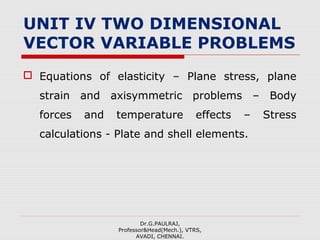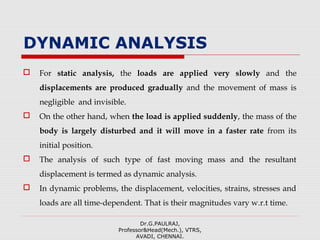This document discusses two-dimensional vector variable problems in structural mechanics. It describes plane stress, plane strain and axisymmetric problems, and provides the stress-strain relations for materials under these conditions. It also discusses thin structures like disks and long prismatic shafts. Additionally, it covers dynamic analysis and vibration of structures, describing free vibration, forced vibration and types of vibration. Equations of motion are developed using Lagrange's approach and the weak form method. Mass and stiffness matrices for axial rod and beam elements are also presented.


















![ So, the element stiffness matrix as,
1 -1
[k]e
=AE/l -------- (7)
-1 1
The element mass matrix as,
1 -1
[m]e
=ρAl/6 -------- (8)
-1 1
Equation (6) can be rewritten as,
-P0
[k]e
[δ]e
= + [m]e
ω2
[δ]e
----- (9)
Pl
Dr.G.PAULRAJ,
Professor&Head(Mech.), VTRS,
AVADI, CHENNAI.](https://image.slidesharecdn.com/feaunit4-190403041849/85/Finite-Element-Analysis-UNIT-4-19-320.jpg)
![ Where [δ]e
contains the nodal d.o.f.
So, the typical free vibration equation
[K]{U} = ω2
[M][U]
Where [K] & [M] = Global, assembled stiffness and mass
matrices.
{U} = Nodal d.o.f.
Dr.G.PAULRAJ,
Professor&Head(Mech.), VTRS,
AVADI, CHENNAI.](https://image.slidesharecdn.com/feaunit4-190403041849/85/Finite-Element-Analysis-UNIT-4-20-320.jpg)



![ Where the shape function N are given by,
N1 = 1 – 3x2
/L2
+ 2X3
/L3
, N2 = x – 2x2
/L + x3
/L2
N3 = 3x2
/L2
-2x3
/L3
, N4 = -x2
/L + x3
/L2
To solve the equation (6), we have the mass matrix as,
156 22L 54 -13L
22L 4L2
13L -3L2
[m]e
= ρAL/420 54 13L 156 -22L ------ (7)
-13L -3L2
-22L 4L2
We observe that the coefficients of the mass matrix
corresponding to translational d.o.f (viz. ρAL/420
(156+54+54+156)) sum up to ρAL, the mass of the element.
Dr.G.PAULRAJ,
Professor&Head(Mech.), VTRS,
AVADI, CHENNAI.](https://image.slidesharecdn.com/feaunit4-190403041849/85/Finite-Element-Analysis-UNIT-4-24-320.jpg)
![CONSISTENT AND LUMPED
MASS MATRICES
Equation for the mass matrix is
[m] = ρ ∫[N]T
[N] dv
Where ρ = Density and N = Shape function or interpolation function.
It is called consistent because the same displacement model that is used
for deriving the element stiffness matrix is used for the derivation of
mass matrix.
Consistent mass matrix equation for bar element:
2 1
[m] = ρAL/6
1 2
Dr.G.PAULRAJ,
Professor&Head(Mech.), VTRS,
AVADI, CHENNAI.](https://image.slidesharecdn.com/feaunit4-190403041849/85/Finite-Element-Analysis-UNIT-4-25-320.jpg)
![ Consistent mass matrix equation for beam element:
156 22L 54 -13L
22L 4L2
13L -3L2
[m] = ρAL/420 54 13L 156 -22L
-13L -3L2
-22L 4L2
Consistent mass matrix equation for Truss element:
2 0 1 0
[m] = ρAL/6 0 2 0 1
1 0 2 0
0 1 0 2
Dr.G.PAULRAJ,
Professor&Head(Mech.), VTRS,
AVADI, CHENNAI.](https://image.slidesharecdn.com/feaunit4-190403041849/85/Finite-Element-Analysis-UNIT-4-26-320.jpg)
![ Consistent mass matrix equation for CST element:
2 0 1 0 1 0
0 2 0 1 0 1
[m] = ρAL/12 1 0 2 0 1 0
0 1 0 2 0 1
1 0 1 0 2 0
0 1 0 1 0 2
Dr.G.PAULRAJ,
Professor&Head(Mech.), VTRS,
AVADI, CHENNAI.
u2
1
x1,y1
vi
3
x3,y3
2
x2, y2
u1
u3
v2
v3
X
Y
CST element
O](https://image.slidesharecdn.com/feaunit4-190403041849/85/Finite-Element-Analysis-UNIT-4-27-320.jpg)

![ 1. Characteristics polynomial methods:
The generalized formula for free vibration is,
[K]{U} = ω2
[M][U] [λ=ω2
]
Where [K] & [M] = Global, assembled stiffness and mass matrices.
{U} = Nodal d.o.f. & λ= Eigen value
(K – λM)U = 0 ----- (1)
If the eigenvector is to be nontrivial, the required condition is,
det(K – λM) = 0
This represents the characteristic polynomial in λ
Dr.G.PAULRAJ,
Professor&Head(Mech.), VTRS,
AVADI, CHENNAI.](https://image.slidesharecdn.com/feaunit4-190403041849/85/Finite-Element-Analysis-UNIT-4-29-320.jpg)



![ Where a1 = Sum of leading diagonal elements
a1 = 4 + 10 – 13 = 1
a2 = Sum of minor of the leading diagonal elements
10 4 4 -10 4 -20
= + +
-30 -13 6 -13 -2 10
a2 = -130 + 120 -52 + 60 + 40 -40 = -2
4 -20 -10
a3 = A = -2 10 4 = 4[-130+120]+20[26-24]-10[60-60]=0
6 -30 -13
Dr.G.PAULRAJ,
Professor&Head(Mech.), VTRS,
AVADI, CHENNAI.](https://image.slidesharecdn.com/feaunit4-190403041849/85/Finite-Element-Analysis-UNIT-4-33-320.jpg)








![ P2: Determine the eigen values and natural frequencies of a
system whose stiffness and mass matrices are given below.
[k] = 2AE/L 3 -1 , [m] = ρAL/12 6 1
-1 1 1 2
Solution:
General F.E equation for longitudinal free vibration of rod is
given by,
{[k] –ω2
[m] } {u} = 0 ----------- (1)
Substituting [k] and [m] matrix in equation (1),
Dr.G.PAULRAJ,
Professor&Head(Mech.), VTRS,
AVADI, CHENNAI.](https://image.slidesharecdn.com/feaunit4-190403041849/85/Finite-Element-Analysis-UNIT-4-42-320.jpg)
![ 2AE/L 3 -1 -ρAL ω2
/12 6 1 u1 = 0
-1 1 1 2 u2
3 -1 u1 = ρL ω2
/24E 6 1 u1
-1 1 u2 1 2 u2
Let λ = ρL2
ω2
/24E
Characteristic equation is given by |[k] – λ[m]| = 0
Dr.G.PAULRAJ,
Professor&Head(Mech.), VTRS,
AVADI, CHENNAI.](https://image.slidesharecdn.com/feaunit4-190403041849/85/Finite-Element-Analysis-UNIT-4-43-320.jpg)


![SOLUTION OF EIGENVALUE
PROBLEMS
The general form of G.E for un-damped free vibration of the structure is
given by
[k]nxn {ui}nx1 = ω2
i [m]nxn{ui}nx1, i= 1, 2, 3.., n ---(1)
Where, [k] = stiffness matrices
[m] = mass matrices
ωi = Natural frequencies
{ui} = Mode shape
Then equ (1) can be rewrite as
[m]-1
[k] {ui} = ω2
i {ui}
[A] {ui} = λi {ui}
Where [A] = [m] λ-1
[k] and λi = ω2
i
Dr.G.PAULRAJ,
Professor&Head(Mech.), VTRS,
AVADI, CHENNAI.](https://image.slidesharecdn.com/feaunit4-190403041849/85/Finite-Element-Analysis-UNIT-4-46-320.jpg)
![ [A] {u} = λ {u} is known as Standard form of eigen value problem.
[k] {u} = λ [m]{u} is known as non-standard form of eigen value
problem.
The determinant | k – λm | = 0 is called as the characteristic equation.
{k – λm } {u} = 0 is called Eigen vector.
Dr.G.PAULRAJ,
Professor&Head(Mech.), VTRS,
AVADI, CHENNAI.](https://image.slidesharecdn.com/feaunit4-190403041849/85/Finite-Element-Analysis-UNIT-4-47-320.jpg)
![ P1: Find the natural frequencies of longitudinal vibration of the
unconstrained stepped bar shown in figure.
Solution:
The dynamic equation of motion
for the un-damped free vibration
of whose system is given by
[ [K] – [M] ω2
] (u) = 0 ------(1)
Where
[K] = Global stiffness matrix
[M] = Global mass matrix
ω = Natural frequency
{u} = Displacement vector
Dr.G.PAULRAJ,
Professor&Head(Mech.), VTRS,
AVADI, CHENNAI.
u3
A(1) = 2A
A(1) = A
Element 1 Element 2
u1 u2
x
1
2
3
l(1) = L/2 l(2) = L/2
Stepped bar with axial degree of freedom](https://image.slidesharecdn.com/feaunit4-190403041849/85/Finite-Element-Analysis-UNIT-4-48-320.jpg)
![ For two element stepped bar, the equation of motion(1) can be derived
as follows:
For element (1): (Between nodes 1&2)
1 -1
Element stiffness matrix [k1] = (A1E1)/l1
-1 1
1 -1 1 -1
= (2A E)/(L/2) = (4A E)/(L) ------(2)
-1 1 -1 1
2 1
Element stiffness matrix [m1] = (ρ1 A1 l1)/6
1 2
(Assumingconsistent mass matrix)Dr.G.PAULRAJ,
Professor&Head(Mech.), VTRS,
AVADI, CHENNAI.](https://image.slidesharecdn.com/feaunit4-190403041849/85/Finite-Element-Analysis-UNIT-4-49-320.jpg)
![2 1 2 1
= (ρ.2A. L/2)/6 = (ρAL)/6 ---(3)
1 2 1 2
For element (2): (Between nodes 2&3)
1 -1
Element stiffness matrix [k2] = (A2E2)/l2
-1 1
1 -1 1 -1
= (A E)/(L/2) = (2A E)/(L) ------(4)
-1 1 -1 1
2 1
Element stiffness matrix [m2] = (ρ2A2 l2)/6
1 2
Dr.G.PAULRAJ,
Professor&Head(Mech.), VTRS,
AVADI, CHENNAI.](https://image.slidesharecdn.com/feaunit4-190403041849/85/Finite-Element-Analysis-UNIT-4-50-320.jpg)
![2 1 2 1
= (ρ.A. L/2)/6 =(ρAL)/12 ------(5)
1 2 1 2
By combining the equas.(2) & (4), we get global stiffness matrix as
2 -2 0
[K] = (2AE)/L -2 3 -1
0 -1 1
Similarly by combining the equas.(3) & (5), we get global mass matrix as
4 2 0 u1
[M]= (ρAL)/12 2 6 1 and {u} = u2
0 1 2 u3
Dr.G.PAULRAJ,
Professor&Head(Mech.), VTRS,
AVADI, CHENNAI.](https://image.slidesharecdn.com/feaunit4-190403041849/85/Finite-Element-Analysis-UNIT-4-51-320.jpg)
![ Now , by substituting the values of above matrices in equation (1) we get
2 -2 0 4 2 0 u1
(2AE)/L -2 3 -1 - (ρAL)/12 2 6 1 ω2
u2 = 0 --(6)
0 -1 1 0 1 2 u3
We know that, for getting the non-zero solution of circular frequency ω
for {u}, the determinant of the coefficient matrix [ [K] – [M] ω2
] should be
zero.
i.e., | [K] – [M] ω2
| = 0
Dr.G.PAULRAJ,
Professor&Head(Mech.), VTRS,
AVADI, CHENNAI.](https://image.slidesharecdn.com/feaunit4-190403041849/85/Finite-Element-Analysis-UNIT-4-52-320.jpg)

![ Then, the equation (7) becomes,
(2-4λ) (-2-2λ) 0
(-2-2λ) (3 -6λ) (-1- λ ) = 0 ----(8)
0 (-1-λ) (1-2 λ)
i.e., (2-4λ) [(3 -6λ) (1-2 λ) - (-1-λ)(-1-λ)] - (-2-2λ) [(-2-2λ) (1-2 λ)-0] +0 = 0
i.e., -36 λ3
+ 90λ2
+ -36 λ = 0
i.e., 18λ(1-2λ) (λ-2) = 0
(or) λ(1-2λ) (λ-2) = 0
In the above equation either λ=0 or (1-2λ)=0 or (λ-2) = 0
When λ = 0 we get (ρL2
ω2
)/24E= 0 => ω2
= 0 (or) ω=0
i.e., the first natural frequency ω1 = 0
Dr.G.PAULRAJ,
Professor&Head(Mech.), VTRS,
AVADI, CHENNAI.](https://image.slidesharecdn.com/feaunit4-190403041849/85/Finite-Element-Analysis-UNIT-4-54-320.jpg)


![ To find the mode shape corresponding to natural frequencies ωi, we
must solve the equation[ [K] – [M] ω2
] (u) = 0.
The equation (6) of the above problem is given by
2 -2 0 4 2 0 u1
(2AE)/L -2 3 -1 -(ρAL)/12 2 6 1 ω2
u2 = 0 ------ I
0 -1 1 0 1 2 u3
By selecting λ = (ρL2
ω2
)/24E the above equation can be simplified as
(2-4λ) (-2-2λ) 0 u1
(-2-2λ) (3 -6λ) (-1- λ ) u2 = 0 ---- II
0 (-1-λ) (1-2 λ) u3
Dr.G.PAULRAJ,
Professor&Head(Mech.), VTRS,
AVADI, CHENNAI.](https://image.slidesharecdn.com/feaunit4-190403041849/85/Finite-Element-Analysis-UNIT-4-57-320.jpg)






![ Generalized governing equation for damping is given by,
[M] { x } + [C]{x} + [K]{x} = F{t} Where C = Damping matrix
There are two categories of methods of solving the above G.E.
They are:
1) Mode superposition methods
2) Direct Integration methods
Dr.G.PAULRAJ,
Professor&Head(Mech.), VTRS,
AVADI, CHENNAI.](https://image.slidesharecdn.com/feaunit4-190403041849/85/Finite-Element-Analysis-UNIT-4-64-320.jpg)